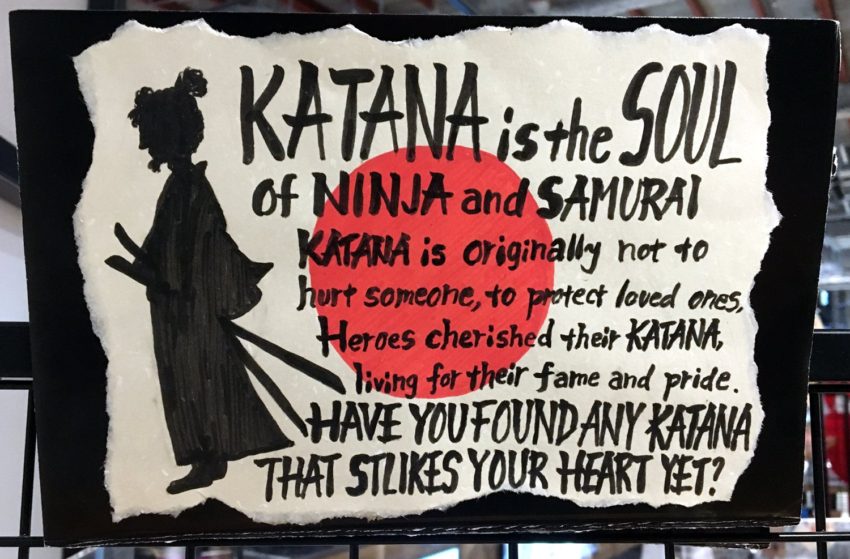The legendary ninjas were a group of people who were trained as spies and assassins in feudal Japan. There is a mystique about them and their methods, even today. One particular reading of the characters in ninjaNINJA 忍者 "stalking/hiding person" learn more... yields the translation “those who endure.” In short, ninjas were those able to execute their missions to the best of their ability and with every fiber of their being. This article concerns everything you might possibly want to know about ninja and, especially, the Japanese ninja sword.
Basics of the Japanese ninja sword
For starters, the Japanese ninja sword has also been termed a ninjaken, ninjato, and, often erroneously, shinobigatana – these are all variations on words for “ninja” and “sword.” Ken can mean “sword” or “fist,” depending on the kanji character, to (pronounced like the English word tow) is a Japanese suffix word for sword, and gatana is just katana (sword), the ‘k’ becoming a ‘g’ due to Japanese grammar.
The odd thing about calling the Japanese ninja sword a katana is that it doesn’t really fit the one trademark quality of a katana: a ninjato is a straight blade, whereas katanas are curved.
Enough about the etymology, what are the details?
The Japanese ninja sword is typically some variety of short sword with straightened construction (akin to a shikomizue) and a squared guard. Overall, the weapon is roughly two feet long, with everything beneath the blade made to be thick and heavy. This is likely due to the fact that ninja would secret away entire slabs of metals suitable for swordsmithing, then forge their own blades, grinding the sharp edges into existence with a stone.
Another possible reason that ninjato are straight-edged is in homage to Fudo Myoo (pronounced “food ohm yo oh”), a patron kamiKAMI 神 "god" learn more... (god) of ninjas clans often depicted armed with such a sword.
Did ninja always carry swords?
The short answer to this question is “yes, usually.” The longer answer is “but only if the mission called for it.” Sometimes a ninja would be sent into an area to serve as nothing more than an information gatherer, possibly disguised as either a komuso monk or an “everyday Joe.” If the area was a risky one, the ninja would likely do his best to conceal his weapons and tools as expertly as possible.
Why did ninja need swords?
Swords were seen as one means to an end, namely the assassination of one or more targets. While ninja were not above resorting to techniques like administering poison, slitting a throat with a dagger, or weaponless elimination, a sword was just another tool for the killing of a target. The relatively short lengths of their weapons enabled drawing and wielding techniques that combined offense and defense in a single strike.
The fact that ninjato are straight also allowed their ninja users to strike with knife-wielding techniques, such as gripping the blade upside down. This allowed the ninja to get a fatal swipe at someone’s neck at the same moment the assassin fled an encounter.
What other weapons did ninjas use beyond the Japanese ninja sword?
Because ninjas were pragmatic by necessity, many of the tools in their arsenal were “multitools.”
- Makibishi (caltrops) – One of the ways a ninja could do some harm would be by dropping a spread of makibishi (little spiked objects that look like jacks) as they fled the scene. If the ninja was fortunate, his pursuers would be stopped in their tracks by the jagged, and possibly poison- or disease-coated, points. A caltrop is a simple metal foot trap that is designed so that at least one of its points is always aligned upward, to its victim’s detriment.
- Tekko-Kagi (climbing claws) – The simplest description of the tekko-kagi would be if you combined metal knuckles with a bear’s claw. While the primary use of these implements was to find purchase for climbing along difficult surfaces, they were broad enough to serve as effective weapons for close-quarters engagements. The multiple prongs also meant that a skilled user could thrust them toward an opponent’s weapon and disarm him with the proper arm motion.
- Shuriken (throwing stars) – While pop culture has promoted the misconception that shuriken were lethal weapons thrown to instantly stop an opponent, the shuriken of the real world were mostly designed for distraction. There are many different designs for shuriken, and some of these designs like the cross-style shuriken are sufficiently useful as close-quarters daggers. The ninja would wrap his hand around the points of one axis, so that the points along the other axis ran parallel with his arm.
- Metsubushi – This tool, nothing more than a egg shell filled with irritants, was used by ninja in a similar manner to shuriken, as a distraction. In the case of metsubushi, these would be thrown at an opponent’s eyes where the various substances, sometimes even glass shards, would make him so miserable that it effectively eliminated any threat he might pose.
- Kunai – Frequently swapping places with shuriken in pop culture, kunai were multi-purpose tools derived from simple trowels, or digging spades. A kunai was a versatile device that could be used variously as a dagger, a spike for climbing or threading rope through, a way to block a door, a tool for intimidating someone from behind into thinking you had a proper weapon pressed to their body, an object to toss aside and distract someone with the clattering noise, and so on. You can see how ninja were open-minded about their weapons. MacGyvers of the underworld.
- Kyogetsu Shogi – This tool consists of a long rope connecting a metal hoop and a small blade that breaks off into two prongs, one straight and one hooking off to the side. This sort of weapon could be used to cut, entangle and trip opponents from a safe distance. Of course, the ninja might also use this tool to strangle a target.
- Firearms – It wasn’t all spooky, old-timey subterfuge. Ninja were perfectly willing to use firearms and gunpowder to meet their goals. They had enough sense to flee the scene after shooting.
- Needles – In situations where concealing a weapon was of the utmost importance, it isn’t hard to imagine a ninja utilizing simple hairpins with points that had been refined to a lethal degree. Some ninja may have been trained in the pressure points of the human body and put that knowledge to work, in tandem with needles, to disable guards.
- Poison – As previously mentioned, ninja were also more than willing to use poison. Whether poison-tipped projectiles, poison placed into someone’s food, or using a larger weapon with a blade tipped into something nasty, there are multiple accounts (and accusations) that someone’s death came at the hand of a poison-dealing ninja.
- Manriki-gusari – While this is simply a chain with a metal weight hanging on each end, a skilled ninja could do many things with such a tool, including: strangulation, using it as a short-range grapple, swinging the weights to knock someone unconscious, etc.
- Kama. This ninja tool is derived from a simple sickle. Beyond the obvious application as a slashing weapon, a kama could be used to trip or disarm opponents, hamstring a fleeing target, or even held as a rudimentary climbing device. Some ninja would modify the kama by affixing a cord or chain to the base of its handle, turning it into a “kusarigama” that afford the wielder all of the benefits of a kama but from a greater distance. Adding a cord also improved the kama’s binding abilities, allowing the user to keep a hostile target hogtied.
Reviewing this impressive list, it’s safe to say that the ninja took their job very seriously and were, unfortunately for their targets, quite adept at getting the job done. Don’t annoy any ninja on your way to the mall tonight.
What is unique about the Japanese ninja sword?
Other than its homemade construction, another unique feature of the ninjato would be its scabbard, or sayaSAYA 鞘 "scabbard/sheath" learn more.... Depending on the particular scabbard, it would not be odd to discover modifications allowing the wily ninja to perform a variety of extra tasks.
- It could be used as an improvised snorkel during missions around bodies of water, as well as just hiding right beneath the surface of a lake.
- Sound amplification from an adjacent room, in a manner similar to placing a glass against a wall to better hear a conversation taking place on the other side.
- Serve as a secret compartment, either for storing various other tools or for smuggling important documents out of a sensitive area.
- Even the tsuba (hilt) of a ninjato may have been used as a tool. Specifically, a ninja could lean the sword against something and use the relatively flat surface of the tsuba as an improvised step. The weapon could then be hoisted up behind him with a simple tug on a cord.
Depictions of the ninjato in media and popular culture
Ninja, and the Japanese ninja sword, have been a feature of popular culture in many countries, not just Japan, for many decades.
- The first photographic evidence of a ninjato can be traced back to 1956, in Heishichiro Okuse’s educational text Ninjutsu.
- The Ninja Museum of Igaryu was established in 1964, and showcased examples of ninjato.
- Also in 1964, ninjato are depicted in a pair of Japanese films belonging to the Shinobi no Mono series.
- Nearly a decade later, in 1973, Black Belt magazine begins to offer ninjato for sale.
- The first American film to showcase the ninjato debuts: 1983’s Revenge of the Ninja.
- A year later, NBC’s “The Master” would become the first American TV show to feature ninjaken.
Today, Japanese sword collectors or other enthusiasts can find a newly-made Japanese ninja sword replica for sale by online vendors and sometimes even in local martial arts shops. The workmanship on these can be quite extraordinary, and they’re a good way to own a piece of an amazing past without having to pay for a museum-quality authentic ninja weapon.

